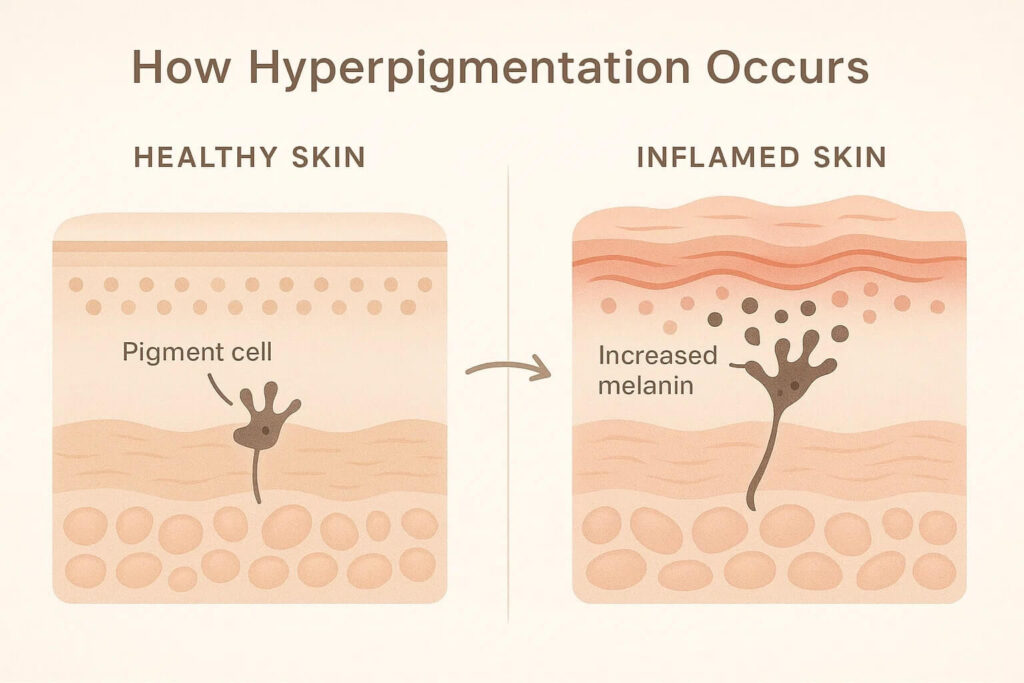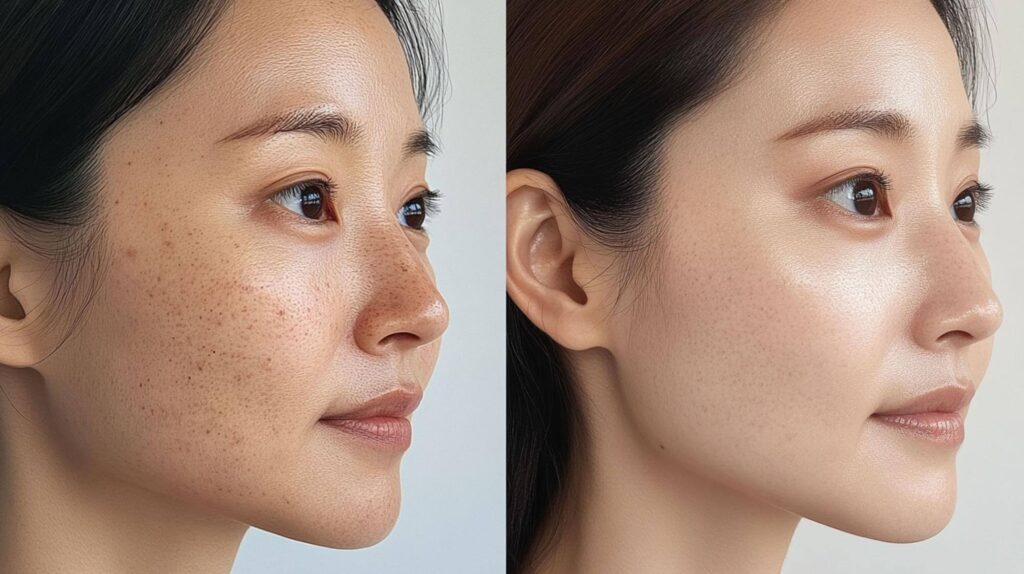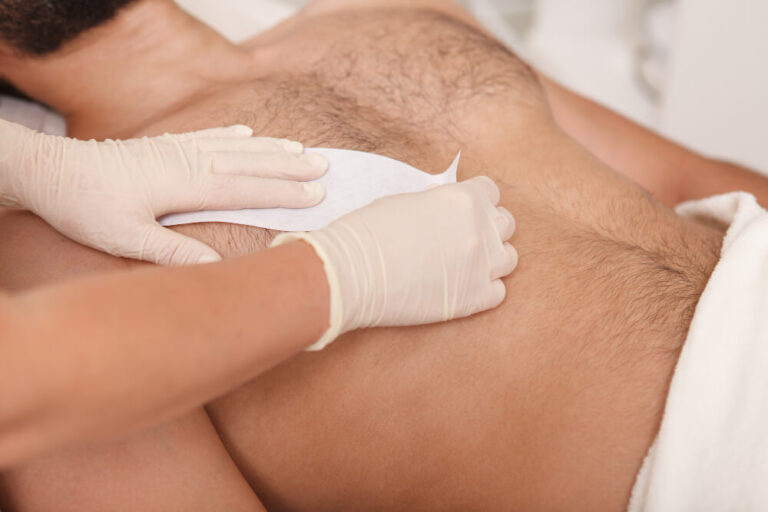If you’ve noticed dark spots or uneven patches on your skin after waxing, you’re not alone. While waxing is a safe and effective way to remove unwanted hair, it can occasionally lead to hyperpigmentation, especially in areas like the bikini line, underarms, or face.
The good news is that this kind of discoloration can often be avoided with the right care and technique. In this article, we’ll explain what causes post-wax hyperpigmentation, who’s more likely to experience it, and what you can do before and after waxing to keep your skin smooth, even, and healthy.
What Is Hyperpigmentation?
Hyperpigmentation happens when the skin produces too much melanin in one area. This leads to darker patches or spots that can appear after inflammation, friction, or skin injury. It’s not harmful, but it can be frustrating, especially when it shows up after something that’s meant to make your skin smoother, like waxing.

These darkened areas are more common on the face, underarms, bikini line, and legs. They’re usually more noticeable on medium to deeper skin tones, but anyone can experience them.
Types of Hyperpigmentation
Understanding what type you’re dealing with can help guide how you treat and prevent it:
- Post-inflammatory hyperpigmentation (PIH): The most common type after waxing. It shows up as flat, brown spots where the skin was irritated or injured.
- Sun-induced pigmentation: UV exposure after waxing can trigger melanin production in newly exposed skin, especially if you skip SPF.
- Hormonal pigmentation (melasma): While not caused by waxing, it can become more visible after skin irritation.

Can Waxing Cause Hyperpigmentation?
Yes, waxing can contribute to hyperpigmentation, especially when the skin reacts with inflammation. During waxing, the top layer of skin is exfoliated and the hair is removed from the root. This process can create minor irritation, which sometimes leads the skin to respond by producing excess melanin, the pigment that gives skin its color.
Factors that increase the likelihood include:
- Overheating the wax
- Waxing over the same area multiple times
- Not following proper post-wax aftercare
- Picking at bumps or ingrown hairs
Who’s More Prone to It?
Some people are simply more susceptible. You may have a higher risk of hyperpigmentation if:
- Your skin tone is medium to deep (Fitzpatrick skin types III-VI)
- You have a history of post-acne marks or dark scarring
- You wax areas that are prone to friction, like the underarms or bikini line
- You expose waxed skin to sunlight without SPF shortly after treatment
Even if you’re prone to pigmentation, waxing doesn’t have to be off-limits. It just means you’ll want to be a little more careful with how you prep and treat your skin before and after each session.

How to Lower Your Risk Before Waxing
Prep Your Skin Gently
Getting your skin ready for a wax can make a real difference in how it responds. The goal here is to reduce the chance of irritation and help your skin handle waxing more smoothly.
Here’s what helps:
- Exfoliate lightly 24-48 hours before your appointment. Use a soft washcloth or a gentle chemical exfoliant (like lactic acid), not a harsh scrub. This removes dead skin and helps prevent ingrown hairs without over-sensitizing the area.
- Hydrate your skin in the days leading up to your wax. Well-moisturized skin is more resilient and less likely to become inflamed.
- Pause active ingredients such as retinoids, AHAs/BHAs, or vitamin C serums at least 2-3 days beforehand. These can thin the skin and make it more reactive during waxing.
Avoid using ice or numbing creams beforehand, as they can tighten pores and make waxing more difficult. Warm skin with open follicles allows for a cleaner, less irritating result.
Choose a Professional Waxing Specialist
Who you trust with your wax matters. Our trained professionals understand how to work with your skin type and can adapt techniques to reduce trauma.
What to look for:
- A salon that uses high-quality, skin-safe wax
- Temperature control, especially in sensitive areas
- Therapists who check skin condition before starting and never double-dip applicators
- A clean, hygienic environment

Best Post-Wax Practices to Prevent Pigmentation
Right after your wax, your skin needs calming, not stimulation. How you treat the area in the first 24 to 72 hours will either support recovery or trigger inflammation, which could lead to dark spots.
Try these skin-friendly steps:
- Apply a cooling gel or lotion with soothing ingredients like aloe vera, chamomile, or calendula
- Use fragrance-free and alcohol-free products to avoid stinging or drying out the area
- Gently pat, don’t rub, when drying off after a shower
Avoid These Triggers
Some habits or products that feel normal in your routine may actually delay healing or spark pigmentation.
What to skip for at least 48 hours:
- Direct sunlight or tanning beds
- Perfumed body washes or lotions
- Exfoliants, scrubs, and loofahs
- Tight clothing that rubs the waxed area
- Intense workouts that create friction or sweat buildup
Sun Protection Is Essential
Freshly waxed skin is more vulnerable to UV damage, even on cloudy days. UV rays can worsen or trigger pigmentation, particularly in exposed areas like the upper lip, arms, or legs.
A few sun-safe tips:
- Apply broad-spectrum SPF 30 or higher daily to all waxed areas
- Reapply every two hours when outdoors
- If you’re in swimwear or shorts, make sunscreen part of your post-wax routine
A solid SPF habit not only helps prevent pigmentation but also protects your skin’s overall tone and texture long-term.
Keep Your Skin Even and Smooth After Waxing
Hyperpigmentation can feel frustrating, but with the right care, it’s often preventable, and treatable. Most dark spots come from inflammation or friction, not the waxing itself. By preparing your skin properly, avoiding common triggers, and following a gentle post-wax routine, you can keep your skin tone smooth and even.
If you’re unsure what products to use or how to adjust your routine, the expert team at Wax&Co is here to help. We specialize in waxing for all skin types and tones, using techniques and products designed to minimize irritation and support healthy, glowing skin.
Whether you’re new to waxing or have experienced hyperpigmentation before, a little extra attention goes a long way.






